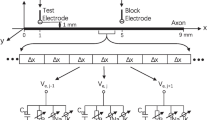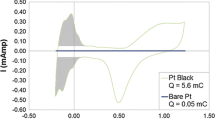Abstract
The mechanisms of nerve conduction block induced by direct current (DC) were investigated using a lumped circuit model of the myelinated axon based on Frankenhaeuser–Huxley (FH) model. Four types of nerve conduction block were observed including anodal DC block, cathodal DC block, virtual anodal DC block, and virtual cathodal DC block. The concept of activating function was used to explain the blocking locations and relation between these different types of nerve block. Anodal/cathodal DC blocks occurred at the axonal nodes under the block electrode, while virtual anodal/cathodal DC blocks occurred at the nodes several millimeters away from the block electrode. Anodal or virtual anodal DC block was caused by hyperpolarization of the axon membrane resulting in the failure of activating sodium channels by the arriving action potential. Cathodal or virtual cathodal DC block was caused by depolarization of the axon membrane resulting in inactivation of the sodium channel. The threshold of cathodal DC block was lower than anodal DC block in most conditions. The threshold of virtual anodal/cathodal blocks was about three to five times higher than the threshold of anodal/cathodal blocks. The blocking threshold was decreased with an increase of axonal diameter, a decrease of electrode distance to axon, or an increase of temperature. This simulation study, which revealed four possible mechanisms of nerve conduction block in myelinated axons induced by DC current, can guide future animal experiments as well as optimize the design of electrodes to block nerve conduction in neuroprosthetic applications.







Similar content being viewed by others
References
Bhadra, N., & Kilgore, K. L. (2004). Direct current electrical conduction block of peripheral nerve. IEEE Transactions on Neural Systems and Rehabilitation Engineering, 12, 313–324. doi:10.1109/TNSRE.2004.834205.
Boyce, W. E., & Diprima, R. C. (1997). Elementary differential equations and boundary value problems, 6th ed pp. 436–457. New York: Wiley.
Chiu, S. Y., Ritchie, J. M., Rogart, R. B., & Stagg, D. (1979). A quantitative description of membrane currents in rabbit myelinated nerve. The Journal of Physiology, 292, 149–166.
Frankenhaeuser, B., & Huxley, A. F. (1964). The action potential in the myelinated nerve fibre of Xenopus laevis as computed on the basis of voltage clamp data. The Journal of Physiology, 171, 302–315.
Hodgkin, A. L., & Huxley, A. F. (1952). A quantitative description of membrane current and its application to conduction and excitation in nerve. The Journal of Physiology, 117, 500–544.
Hopp, F. A., Zuperku, E. J., Coon, R. L., & Kampine, J. P. (1980). Effect of anodal blockade of myelinated fibers on vagal C-fiber afferents. The American Journal of Physiology, 239, R454–R462.
Kuffler, S. W., & Gerard, R. W. (1947). The small-nerve motor system to skeletal muscle. Journal of Neurophysiology, 10, 383–394.
Loeb, G. E. (1989). Neural prosthetic interfaces with the nervous system. Trends in Neurosciences, 12(5), 195–201. doi:10.1016/0166-2236(89)90071-4.
Manfredi, M. (1970). Differential block of conduction of larger fibers in peripheral nerve by direct current. Archives Italiennes de Biologie, 108, 52–71.
McIntyre, C. C., Richardson, A. G., & Grill, W. M. (2002). Modeling the excitability of mammalian nerve fibers: influence of afterpotentials on the recovery cycle. Journal of Neurophysiology, 87, 995–1006.
Mendell, L. M., & Wall, P. D. (1964). Presynaptic hyperpolarization: a role for fine afferent fibers. The Journal of Physiology, 172, 274–294.
Petruska, J. C., Hubscher, C. H., & Johnson, R. D. (1998). Anodally focused polarization of peripheral nerve allows discrimination of myelinated and unmyelinated fiber input to brainstem nuclei. Experimental Brain Research, 121, 379–390. doi:10.1007/s002210050472.
Rattay, F. (1989). Analysis of models for extracellular fiber stimulation. IEEE Transactions on Bio-Medical Engineering, 36, 676–682. doi:10.1109/10.32099.
Rattay, F. (2008). Current distance relations for fiber stimulation with pointsources. IEEE Transactions on Bio-Medical Engineering, 55, 1122–1127. doi:10.1109/TBME.2008.915676.
Rattay, F., & Aberham, M. (1993). Modeling axon membranes for functional electrical stimulation. IEEE Transactions on Bio-Medical Engineering, 40, 1201–1209. doi:10.1109/10.250575.
Roth, B. J. (1994). Mechanisms of electrical stimulation of excitable tissue. Critical Reviews in Biomedical Engineering, 22, 253–305.
Sassen, M., & Zimmermann, M. (1973). Differential blocking of myelinated nerve fibers by transient depolarization. Pflugers Archiv, 341, 179–195. doi:10.1007/BF00592788.
Schwarz, J. R., & Eikhof, G. (1987). Na currents and action potentials in rat myelinated nerve fibres at 20 and 37°C. Pflugers Archiv, 409, 569–577. doi:10.1007/BF00584655.
Schwarz, J., Reid, G., & Bostock, H. (1995). Action potentials and membrane currents in the human node of ranvier. Pflugers Archiv European Journal of Physiology, 430(2), 283–292. doi:10.1007/BF00374660.
Tai, C., & Jiang, D. (1994). Selective stimulation of smaller fibers in a compound nerve trunk with single cathode by rectangular current pulses. IEEE Transactions on Bio-Medical Engineering, 41, 286–291. doi:10.1109/10.284949.
Whitwam, J. G., & Kidd, C. (1975). The use of direct current to cause selective block of large fibers in peripheral nerves. British Journal of Anaesthesia, 47, 1123–1133. doi:10.1093/bja/47.11.1123-b.
Zimmermann, M. (1968). Selective activation of C-fibers. Pflugers Archiv fur die Gesamte Physiologie des Menschen und der Tiere, 301, 329–333. doi:10.1007/BF00362643.
Acknowledgement
This work is supported by the NIH under grants R56-DK-068566, R01-NS-051671, and R01-DK-077783.
Author information
Authors and Affiliations
Corresponding author
Additional information
Action Editor: David Terman
Rights and permissions
About this article
Cite this article
Tai, C., Roppolo, J.R. & de Groat, W.C. Analysis of nerve conduction block induced by direct current. J Comput Neurosci 27, 201–210 (2009). https://doi.org/10.1007/s10827-009-0137-7
Received:
Revised:
Accepted:
Published:
Issue Date:
DOI: https://doi.org/10.1007/s10827-009-0137-7




